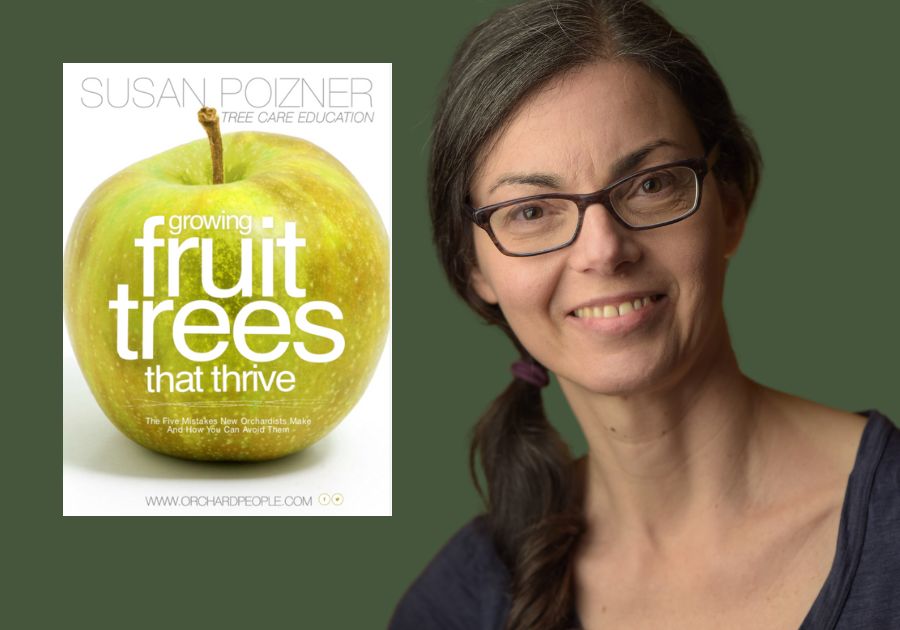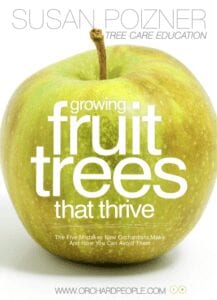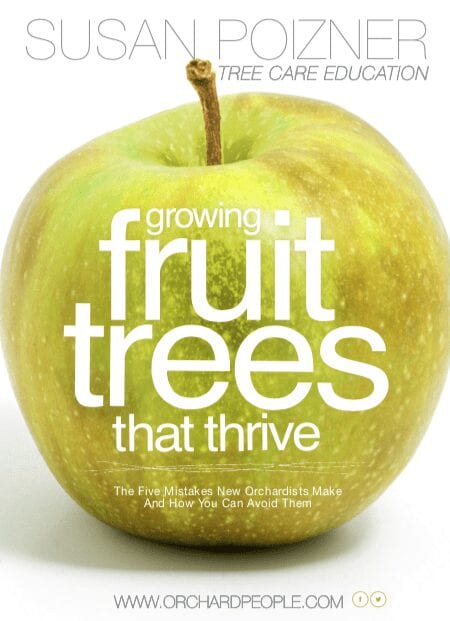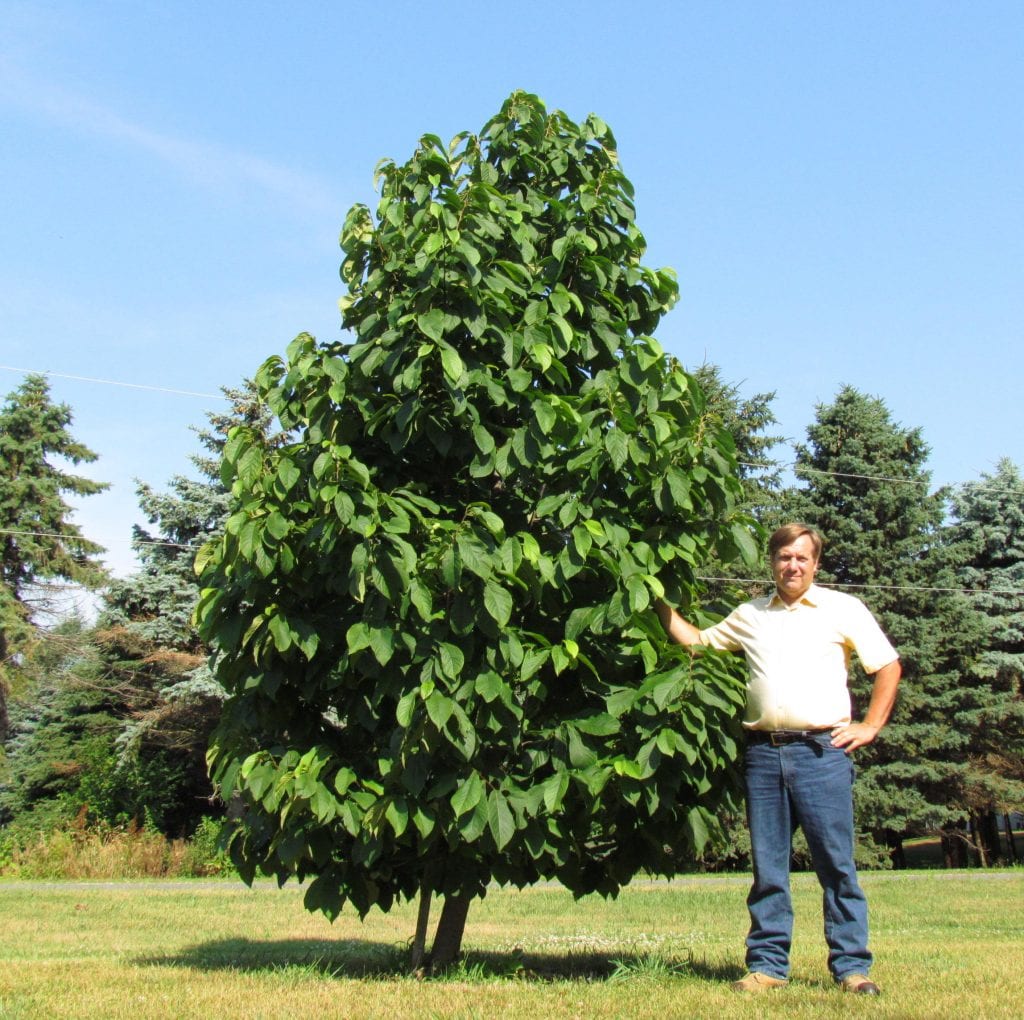

FRUIT TREE CARE NEWSLETTER
The Power of the Pawpaw Tree: Bridging the Past to the Future

Isaac Cosby remembers being a young child when he first had a taste of the fruit from a pawpaw tree. At 6-years-old he loved and trusted his grandfather, but when his “papa” first offered this strange, slimy-looking fruit, Isaac thought that his papa was teasing him. But one taste changed his attitude about pawpaws forever. This pawpaw fruit was so sweet and special that Isaac, Lead Hand in Urban Agriculture at Evergreen Brickworks, has been fascinated with it ever since.
In episode 53 of The Urban Forestry Radio Show and Podcast, Isaac explains that a member of the Ojibwe First Nations, he grew up around natural pawpaw forests and other sources of wild crops such as blackberries and asparagus. While the pawpaw is a very tasty fruit, in his community it also had some other purposes. Bark of the pawpaw tree was woven into ropes, nets, and mats for stringing fish. The pawpaw fruit itself was often thought to have medicinal uses and is currently being studied for its cancer fighting powers.
Pawpaws are a beautiful and useful native North American tree that grow from the southern states of Tennessee and Arkansas all the way up to southern Ontario. So, in this article, we will explore:
- Pawpaw tree history
- The pawpaw tree’s habitat and landscape use
- The pawpaw fruit
- How to grow pawpaw trees
- Pawpaw tree pest and disease challenges
- And more!
So let’s dig in!

Where do pawpaw trees grow best?
The pawpaw has a rich history in the Native American diet and way of life. But when European settlers arrived, the native inhabitants introduced them to this wonderful fruit. Pawpaws then became ingrained into the traditional folklore song “Way Down Yonder in the Pawpaw Patch. ”
Where, oh, where is sweet little Nellie?...
Traditional Folk Song
Way down yonder in the paw paw patch
Come on, boys and let's go find her…
Way down yonder in the paw paw patch
Pickin' up paw paws, put 'em in your pocket…
Way down yonder in the paw paw patch
In the folk song, Nellie finds her pawpaw in a pawpaw patch. In fact, pawpaws are often found in groups as pawpaw trees sucker very easily, creating more root sprouts off of the original tree, quickly adding more pawpaw trees to the area!
As young plants, pawpaw trees do not like the full sun, so they should be planted in a shaded area. At about 1-2 years of age the pawpaw tree is still susceptible to wind and direct sunlight as UV can kill them. As they age, pawpaw trees can tolerate more sun and wind.

What do pawpaw trees look like?
This beautiful tree, which is also known as American Custard Apple, West Virginia Banana, and Indiana Banana, has become a popular landscape plant as it produces delicious and tropical-tasting fruit but is also very beautiful looking.
“The first thing I notice is how distinctive the leaves are. They look like no other tree,” Paul Decampo, a self-confessed pawpaw propagandist also interviewed in episode 53 of The Urban Forestry Radio Show and Podcast.
Pawpaw trees have large, long, tear-drop shaped leaves, unlike many other fruit trees grown in North America. Pawpaw tress can also grow to a fairly large size, up to 11 metres (35 feet) tall and 20-30 cm (8-12 inches) wide in the trunk. The blossoms are a deep maroon colour, trying the mimic red meat colours as the are pollinated by midges and flies.

To attract these pollinators, pawpaw blossoms also have a foul scent, a decaying corpse or meat smell. However, it is very subtle so you likely won’t even smell it, according to Dan Bisonette, author of The Pawpaw Grower’s Manual for Ontario.
“The scent is so subtle, I practically have to bury my in the blossoms to pick up anything,” he said in episode 19 if The Urban Forestry Radio Show and Podcast. In that show he talked about growing and caring for pawpaw trees.
So no need to avoid pawpaws during blossom!
What does the pawpaw fruit taste like?
As native trees, pawpaw trees aren’t hard to grow. But are they worth it? If you love delicious, organic homegrown fruit they definitely are! The pawpaw has a very complex flavour profile with the similar sliminess of a mango, the creamy custard texture, and bit of banana, with an aftertaste of pear.
Dan Bisonette explains that the pawpaw fruit is to be savoured slowly.
“To quickly chew it and swallow it is to shortchange the experience,” he says.
The fruit may also taste very different depending on where it is grown as pawpaws from Ontario will taste different than pawpaws from Tennessee.
According to Paul DeCampo it’s also great in desserts, as “it really takes advantage of the banana-like character of the fruit. The custard character really goes well in gelato.”
You will never see pawpaw fruit in your local supermarket as it is very perishable and doesn't transport well. But pawpaw are wonderful in many different confectionaries and sweets ranging from loafs and muffins to desserts such as ice creams, gelatos, and puddings.
Not only does this complex fruit add some sweetness, but it is also rich in vitamin C, magnesium, iron, manganese, among other nutrients to boost a healthy diet.
how do you plant a pawpaw tree?
You can buy a bare root tree, potted pawpaws, or even pawpaw seeds. All of these are great options, it will depend on your preference for your choice.
Planting a bare root tree may be risky as it many unintentionally get damaged or even removed. A bare root tree is a dormant tree with no soil attached to roots. Roots may be wrapped to stay hydrated. You want to plant the tree when it is dormant, late April to very early May, just as the buds are breaking
If you are transplanting a potted pawpaw tree, it is best to plant it around late April or early May, with more flexibility in timing in the States. Pawpaw roots like room to grow, so the pawpaw tree should only be kept potted for around 4 years.
How to grow a pawpaw tree from seed
Pawpaw seeds need almost 3 months of time in a cool, dark, and moist environment. You can keep your seeds in a refrigerator or you can plant them in soil in the fall season, to germinate. When seeds are kept in the refrigerator, they should be kept moist but not wet. To break dormancy these seeds should be soaked in warm water for a day before planting in the ground or pots. Pawpaw seedlings take about a month to sprout.
Do you need two pawpaw trees to produce fruit?
Now, if you're planting your pawpaw tree to beautify your garden, you only need one tree. But if you want to enjoy the fruit, you'll need to plant more than one pawpaw tree.
That's because pawpaw trees need pollination partners so that they can exchange pollen with a genetically different pawpaw tree that's planted nearby.
And even if you have a perfectly matched pair of pawpaw trees, you might still have to wait quite a while until you can enjoy the harvest. That's because pawpaw trees need from 2 to 8 years before they are mature enough to produce fruit!
How to prune a pawpaw tree
According to pawpaw expert Dan Bisonette, Pawpaws don’t respond well to pruning or grafting. Only prune crossing branches and branches that are dead, damaged, or diseased.

Pawpaw tree pest and disease problems
Pawpaws do release acetogenins, a natural pest deterrent. However, some common pests are small mammals, deer, bears and the Pawpaw peduncle borer, spider mites, caterpillars, and Japanese beetles. Pawpaws can protect themselves against blight and mould if planted in areas with good drainage and air flow.
When to expect the harvest
The pawpaw's fruit begins to ripen in mid august through to September. The best way to know if pawpaw is if squeezed, the fruit will smush and the fruit will easily come off the tree.
Join the pawpaw movement!
Paul DeCampo calls himself a “Pawpaw-gandist” and he encourages people around the city of Toronto and beyond to plant these native trees on their properties.
Paul learned about the trees in early 90s and started his pawpaw journey by planting two trees in his front yard. Now he has a pawpaw patch with multiple trees and that produces lots of fruit.
Paul believes in “using native plants to restore habitat” and that pawpaws are beneficial in this as since “they are native to the area, they are co-evolved with all the insects and diseases that are here so they’re not susceptible to them and they host many important species as well.”
And if you want to become a pawpaw enthusiast yourself, you may want to check out the annual Ohio Pawpaw Festival which is held in Lake Snowden, a town located just outside of Albany, Ohio. This is a three-day festival that occurs annually in mid September to align with pawpaw harvest. There are activities for all ages at this festival from growing and cooking pawpaws, to eating pawpaw and drinking pawpaw brew to even races and bike rides.
Have you ever tried a pawpaw before? Would you like to? With the pawpaw’s brilliant long, green leaves and its rich maroon blossoms, planting a pawpaw tree in your garden can add a little slice of tropical paradise to your life, whether you are in the southern states or southern Ontario. So, what do you say? Meet you down yonder in the pawpaw patch!
Interested in learning more about growing and caring for fruit trees successfully? Check out OrchardPeople.com's premium online courses.

The author of this article is Loretta Higgins, an intern at OrchardPeople.com. She is a student at the University of Guelph and her passions include sustainable living on her family farm and athletics of all kinds.

